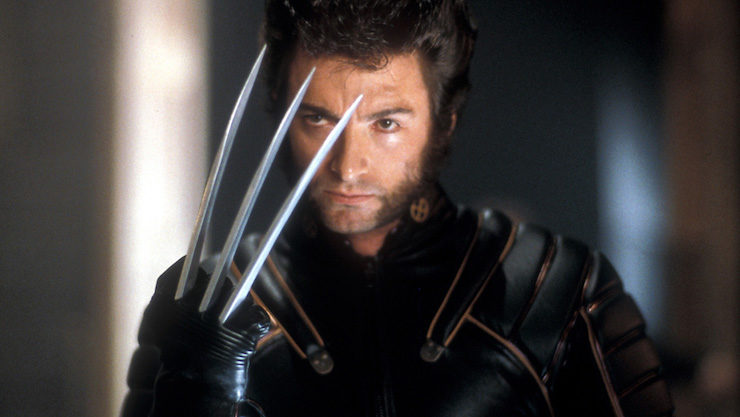The X-Men were not, initially, one of Marvel’s successes. Part of the wave of superheroes created in the early 1960s by Stan Lee, Jack Kirby, and Steve Ditko, the X-Men never quite captured the reading public’s imagination the way the Fantastic Four, Thor, Iron Man, the Hulk, the Avengers, and Spider-Man did.
In 1975, that changed. Len Wein & Dave Cockrum provided a new team of X-Men in Giant-Sized X-Men #1, and then Chris Claremont took over writing duties with the following Uncanny X-Men #94, and a legend was born. Providing a multiethnic team of mutants along with founding member Cyclops, the title quickly became one of Marvel’s most popular (it’s almost like diversity sells or something!), particularly once Claremont was joined by artist/co-plotter John Byrne, with whom he’d also had successful runs on Iron Fist, Star-Lord, and Marvel Team-Up.
By the late 1980s, there were no comic book heroes more popular than the X-Men. That was when they started the process of trying to bring them to the big screen, but it took a while.
The X-Men in the 1960s were more B-list, like Daredevil and Dr. Strange, and every attempt to breathe life into the book failed, from giving them distinct costumes instead of similar black-and-yellow school uniforms to killing off their mentor Professor Charles Xavier to bringing in and up-and-coming artist Neal Adams to do the artwork. Finally, in 1969, Marvel pulled the plug on the title, still releasing it bimonthly as a reprint, but with the team itself no longer part of Marvel’s day-to-day.
By the time Claremont and Byrne were cooking with gas in the 1980s, Marvel tried to get the comic made into a film, but the project was seriously snakebit. They had a deal with Orion Pictures, but then Orion had financial issues. They had a deal with CarolCo, which then went out of business. Columbia Pictures wasn’t interested.
Finally, 20th Century Fox picked up the rights after the studio’s TV network, FOX, developed a hugely successful animated series in 1992. After several more false starts, it finally wound up in the hands of Bryan Singer following the success of The Usual Suspects. (Amusingly, one of the directors considered was Brett Ratner, who would eventually direct the third film in the series when Singer quit to direct Superman Returns.)
Sir Patrick Stewart—having come to prominence playing a regal bald father figure who sat in a chair giving orders—was ideal casting as Xavier, and was in fact the only person longtime Trekkie Singer would consider. Sir Ian McKellen had worked with Singer on Apt Pupil, and proved a perfect Magneto. Originally Cyclops and Wolverine were to be played by James Caviezel and Dougray Scott, respectively, but scheduling conflicts forced them to back out, the former for Frequency, which was a starring role for him, the latter for Mission: Impossible 2, which started filming late due to Stanley Kubrick doing tons of reshoots for Eyes Wide Shut.
For the latter role, they had originally approached Russell Crowe, but he turned it down, recommending his fellow Aussie Hugh Jackman, who wound up getting the role after Scott had to back out. It proved a breakout role for Jackman, who pretty much owes his career to Kubrick being a perfectionist.
“What would you prefer, yellow spandex?”
X-Men
Written by Tom DeSanto & Bryan Singer and David Hayter
Directed by Bryan Singer
Produced by Lauren Shuler Donner & Ralph Winter
Original release date: July 12, 2000
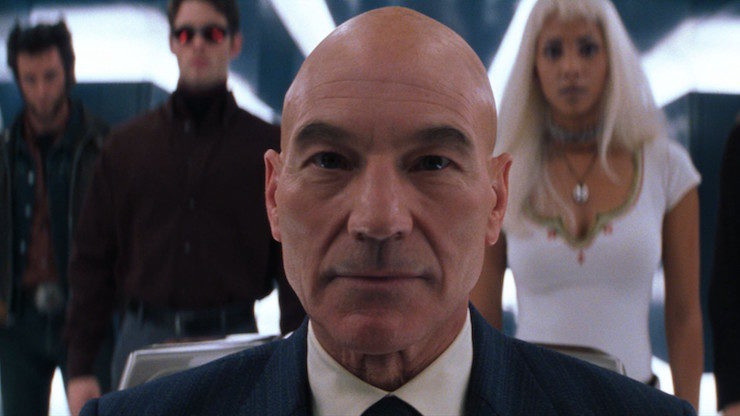
Poland, 1944, a young boy named Eric Lehnsherr is separated from his parents by Nazi soldiers. He is able to mentally mangle the gate that separates them before he is clubbed in the head by a rifle.
Cut to the near future, and Dr. Jean Grey is testifying before Congress with regards to the proposed Mutant Registration Act. She is, however, shouted down by Senator Robert Kelly, who believes that mutants are dangerous and need to be registered. Considerations of human rights are never heard over Kelly’s shouting and everyone’s applauding.
Also in the audience are the now much older Lehnsherr, who goes by the sobriquet “Magneto,” as well as his old friend Professor Charles Xavier. Xavier confronts Magneto, who says there’s a war between humanity and mutants coming, and Xavier would be best to stay out of Magneto’s way.
A young girl named Marie in Mississippi kisses her boyfriend, and he falls into a coma at their touch. Fearful, she runs away, eventually winding up in Canada, where she encounters a man nicknamed “Wolverine” getting into bar fights and winning them for money. However, when one sore loser complains, Wolverine unsheathes claws from his knuckles. The bartender throws him out, calling him a freak. Wolverine leaves, with Marie—who now is calling herself “Rogue”—stowing away in his trailer. Wolverine leaves her behind at first, but gives in and lets her come along, saying his real name is Logan.
They’re ambushed by Sabretooth, a leonine mutant who cuts a tree down so it falls on Wolverine’s RV. Sabretooth, in turn, is ambushed by Cyclops and Storm, two mutants who take the unconscious Wolverine and Rogue back to Westchester to the Xavier School for Gifted Youngsters. Wolverine awakens in the infirmary and soon realizes he’s in a gigunda mansion that doubles as a school for mutants. Xavier gives him the nickel tour, and he meets the senior students, the so-called “X-Men”: besides Storm, real name Ororo Munroe, and Cyclops, real name Scott Summers, there’s Grey, whom Wolverine attacked when he awakened, though she forgives him.
Wolverine is less than impressed with the school, though he is glad that Rogue has found a place where she can approach the possibility of being an ordinary kid. Rogue even befriends one of her fellow students, a young boy named Bobby Drake, who can freeze things.
Sabretooth returns empty-handed, telling Magneto that the mutant escaped with Xavier’s people. Magneto is disappointed, but not surprised.
Kelly gets into a helicopter with his aide, Henry Peter Gyrich—except it turns out that Gyrich is dead, and has been for some time, replaced by the shapechanger Mystique. She subdues Kelly and she and Toad, who is piloting the helicopter, bring him to Magneto’s island redoubt. Magneto then demonstrates his new toy: a machine that uses Magneto’s own powers of magnetism to send out a wave that rewrites homo sapiens DNA to make them into mutants. After activating the machine on Kelly—and after being helped away by Mystique, as use of the machine takes a lot out of him—Magneto has the senator imprisoned until his mutation kicks in.
Grey reveals the results of her examination of Wolverine: his entire skeleton has been laced with adamantium, which is also what his claws are made of. He has superb regenerative abilities, granting him the ability to heal any wound, making it impossible to determine his age. It’s also how he was able to survive the procedure done to his skeleton. He has no memory of the procedure or of anything else in his life prior to about fifteen years previous. Xavier offers to help him unlock his memories and also help him figure out why Magneto attacked him.
That night, Wolverine has a nightmare, getting flashes of the procedure that gave him his adamantium skeleton. Rogue hears his screams and checks on him. Wolverine wakes up and accidentally stabs her. She reaches out and touches him, absorbing his psyche and his powers as well, enabling her to heal her wounds.
Later, Bobby approaches her, telling her that Xavier’s furious that she used her powers on another mutant and that she’d be better off if she ran away. Rogue believes “him”—it’s actually Mystique in disguise—and runs away. When the X-Men realize she’s gone, Xavier brings them and Wolverine down to Cerebro. It’s a device that enhances Xavier’s telepathy, enabling him to find any mutant. (Magneto has managed to keep himself hidden from the machine. Xavier also reveals that Magneto helped Xavier design Cerebro.)
Xavier tracks Rogue to the local train station. Wolverine steals Cyclops’s motorcycle and heads there, Cyclops and Storm not far behind in a car. Wolverine convinces Rogue to go back to the school—but then Magneto and his brotherhood attack. Toad uses his prehensile tongue to knock Cyclops’s visor off, thus letting his optic blasts loose in the train station, while Sabretooth chokes Storm, though she manages to hit him with a lightning bolt.
Magneto, meanwhile, attacks the train, easily neutralizing Wolverine by controlling his metal skeleton. Magneto then reveals his true target: Rogue. Xavier tries to stop him by taking telepathic possession of Sabretooth and Toad (Magneto’s helmet makes him immune to Xavier’s telepathy), but Magneto counters by threatening to kill the cops surrounding the train station with their own (metal) weapons. Xavier lets him go with Rogue.
While this was going on, Mystique, still posing as Bobby, changes her shape to that of Xavier in order to enter Cerebro, which she then sabotages.
Kelly mutates into a semi-liquid form that enables him to squeeze himself through the bars of Magneto’s cell and plummet into the ocean. He comes aground on a beach, now with gills, passing by a hot dog vendor who looks just like Stan Lee, and heads to Xavier’s School. Xavier scans his mind, and learns what Magneto is planning.
When Xavier tries to use Cerebro to locate Rogue, Mystique’s sabotage puts Xavier in a coma. Grey tries using Cerebro herself, after she reverses Mystique’s jiggery-pokery, and it almost kills her, but she discovers that Rogue is at the Statue of Liberty.
There’s a UN summit at Ellis Island, and Magneto’s plan is to have Rogue absorb his powers so she can power the device, which he’ll have placed on the nearby Statue of Liberty. Then a whole mess of world leaders will become mutants, thus leveling the playing field a bit. What Magneto doesn’t know is that his initial experiment was a failure: Kelly’s body rejected the mutation, and he died, turning to pure water right in front of Storm’s eyes.
Cyclops, Storm, Wolverine, and Grey take the X-Men’s stealth jet to Manhattan and storm the Statue of Liberty. Mystique poses as Wolverine, and she and the real McCoy fight. Toad takes out Grey and Storm, but the latter recovers and tosses the mutant into the ocean while uttering one of the ten silliest lines in cinema history. (“You know what happens to a toad that’s hit by lightning? The same thing that happens to everything else.”)
Wolverine stops Mystique, leaving only Magneto and Sabretooth. The former easily traps the X-Men, but when Magneto goes off to let Rogue absorb his powers, Wolverine manages to escape and, rather than free the others, he gets into a fight with Sabretooth. Eventually, he defeats the big guy and frees his new teammates.
Storm uses a heavy wind to send Wolverine to the tower to break Magneto’s machine, with Grey steadying him telekinetically. Unfortunately, Magneto resists Wolverine’s attack with his control over the latter’s skeleton and claws. However, that’s enough of a distraction that Cyclops is able to take a shot, disabling Magneto.
The world leaders are saved, Magneto is put in an entirely plastic prison (where Xavier visits him to play chess), and Rogue re-enrolls in Xavier’s School. Mystique has replaced Kelly in the senate and reversed his vote on the Mutant Registration Act, which means it won’t pass now, as all the people he convinced to support it have also reversed their votes. Finally, Xavier has found a lead on Wolverine’s past: a now-abandoned facility in northern Canada. Wolverine heads there, leaving Rogue his dogtags, reassuring her that he’ll be back for them. Then he rides off on Cyclops’s motorcycle.
“Does it hurt?” “Every time.”
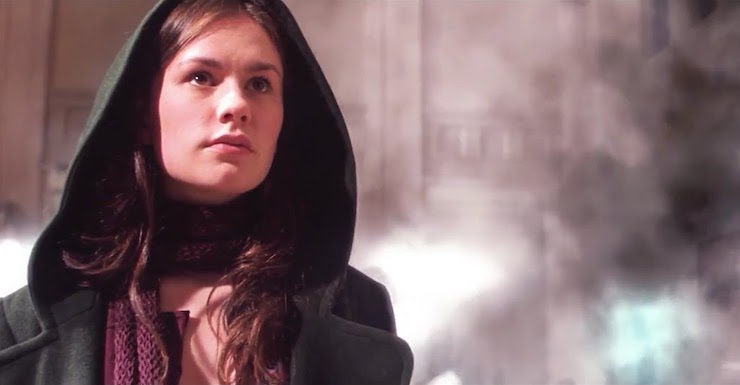
To call the history of the X-Men “complicated” is the gravest of understatements. As the X-Men grew in popularity throughout the late 1970s and early 1980s, numerous characters kept getting added to the mythos, plot threads were left dangling, characters lived, characters died, and the cast just kept growing and growing. Various spinoff teams were created over the decades: the New Mutants, who became X-Force; X-Factor; Excalibur; Generation X; the Exiles; and more. Plus various characters got solo titles, including Wolverine, Cable, Gambit, Deadpool, etc. Time travel was introduced in the seminal story “Days of Future Past” in Uncanny X-Men #141 in 1981, and became an integral part of the X-Men storyline.
So the challenge in doing an X-Men movie was always finding a way to boil it down to something easily digestible and not confusing to a mass audience. And dammit if Bryan Singer and company don’t pull it off beautifully.
The main reason why X-Men works so well is that Singer understands that the fundamental conflict in the X-Men titles is actually quite simple: the conflict between Xavier (mutant rights and peaceful coexistence) and Magneto (superior mutants should rule the inferior humans). Rather than flood the viewer with a billion characters, he keeps the team small and manageable to start, with really only three X-Men initially, and using Wolverine and Rogue as the entry points for exposition, as the viewer learns of the X-Men alongside Logan and Marie.
Most of the casting is perfect here, starting with those two flashpoint characters. Stewart and McKellen were pretty much born to play Xavier and Magneto, and they absolutely nail the dynamic that we’ve been seeing in the comics since 1963. (It also starts a personal and professional tandem that has been a delight to follow, from here all the way to Waiting for Godot on Broadway and beyond.) Jackman is a revelation in his breakout role, perfectly inhabiting one of comic-dom’s most iconic characters. Ray Park is a delight as the Toad, Bruce Davison works nicely as the antagonistic Kelly, and Anna Paquin is superb as a version of Rogue that is truly a kitbash of Rogue, Jubilee, and Kitty Pryde, mixing the powers and backstory of the former with the latter two’s roles as Wolverine’s protegée. (Amusingly, we also see both Jubilee and Kitty as students in the school.)
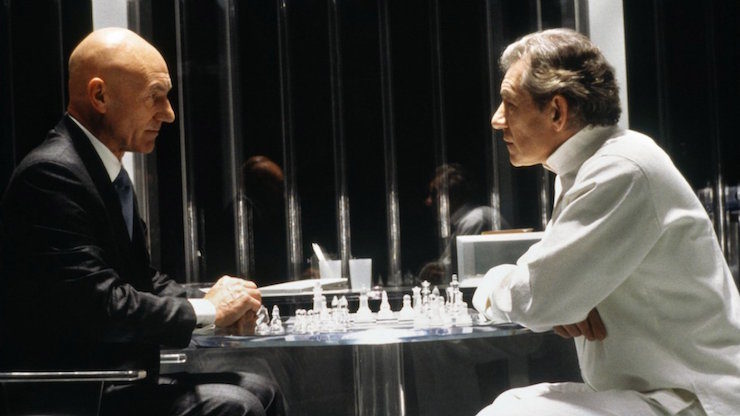
The others are a bit more hit-and-miss. Famke Janssen gets almost nothing to do as Grey, Halle Berry never quite comes together as Storm, and Tyler Mane is simply awful as Sabretooth. James Marsden is criminally underused as Cyclops, though he, at least, makes the most of what he’s given; the scene where he talks to the comatose Xavier is heartbreaking and he holds his own in the Wolverine-Cyclops rivalry even though it’s so obviously tilted in favor of Wolverine in the scripting.
Not only does Singer boil down the core conflict, he shows its many aspects in a lot of quick, impressive, quiet ways. The simple reality of Magneto coming of age in a concentration camp tells you a lot of what you need to know about him, and that prologue is impressively understated. Rogue’s longing look at the mother and child on the train touching each other is her entire character in a nutshell, while her query to Wolverine asking if it hurts when he uses his claws and his two-word response likewise tells you everything you need to know about Logan. It takes no time at all to establish the relationships, from the Cyclops-Grey-Wolverine love triangle to the aforementioned Cyclops-Wolverine rivalry (Logan giving Summers the middle claw is one of the greatest moments in superhero moviedom) to the longstanding friendship gone sour between Xavier and Magneto.
And all the modes of Xavier’s School are here, both its function as a school for mutants (seen primarily in the earliest days of the comic, as well as in The New Mutants, Generation X, and several other places) and as the headquarters for a superhero team. The theme of prejudice against mutants is front and center, from Kelly’s rabble-rousing at the top of the movie to the frightened reactions people have to mutants using their powers generally (notably Wolverine being kicked out of the bar, not to mention the civilians’ response to the ambush at the train station). And Magneto’s not a pure villain—showing him in the camps makes that impossible—but the film doesn’t let him off the hook, either. In particular, Wolverine calls him on his bullshit for using Rogue, saying if he really had the courage of his convictions, he’d power the machine itself. Magneto talks of Rogue’s sacrifice for the greater good, but it doesn’t really count as a sacrifice when you’re coerced…
The movie is far from perfect. The action scenes are, bluntly, disastrous. The X-Men do fine when rescuing Wolverine, but are totally incompetent throughout the train station attack and the Lady Liberty battle. The latter is especially frustrating, as the Toad runs rings around Storm and Grey for about five minutes, mostly because it never occurs to either of them to actually use their powers. (The microsecond Storm does, of course, Toad’s toast.) Cyclops does a great deal of standing around when he should be using his powers, which mostly seems to be to prolong the fight scenes.
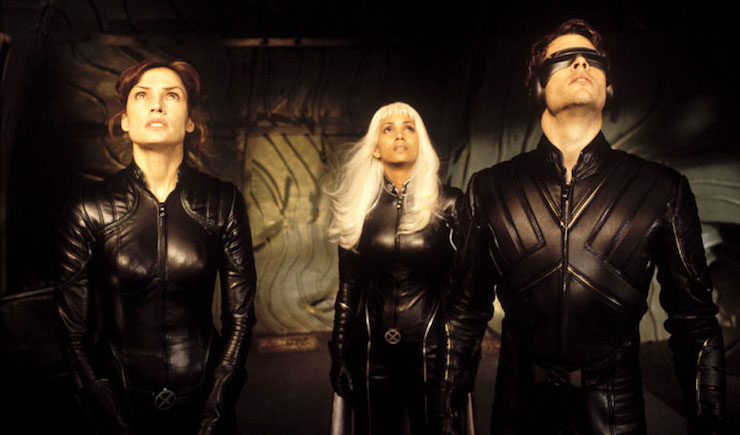
Storm is particularly ill-served. She controls the weather, which makes her immensely powerful, but Singer only seems to be willing to let her be a fog machine and a lightning thrower. When they’re bound in the statue, Cyclops orders Storm to zap him, and Magneto scoffs that bringing down lightning on a giant copper structure that they’re all attached to is a spectacularly stupid idea. And he’s right—but what about the ninety million other things Storm can do? Or why can’t Grey just telekinetically work at their bonds? (I mean, okay, Magneto’s probably stronger, but he’s about to sacrifice at least some of his power to Rogue.) And then Wolverine is the one who breaks out, but does he free his teammates? Nope, he has to fight Sabretooth, because they need to have a proper Wolverine/Sabretooth fight. (Though these two don’t have the past relationship that Wolverine and Sabretooth have in the comics; we’ll see a different version of Sabretooth, a.k.a. Victor Creed, who does have that relationship with Logan in X-Men Origins: Wolverine.)
The hardest part of adapting a serial work of fiction to the screen—particularly to a two-hour movie—is to find the right story to tell. Oftentimes the first one can be the origin, but that doesn’t always work with a team storyline. Singer has done what not enough people did before him, though plenty have done since: find that story and make it work both as a movie and as an adaptation of a comic book. While the subsequent X-films would be hit-and-miss in that regard, he started off very much on the right foot with this first film.
More to the point, Singer proved that you can do a good adaptation of a comic book that’s actually true to the comic, something that had been, as we’ve seen, vanishingly rare, especially from Marvel up to this point. For all that the details were streamlined and simplified, at its heart this is 100% an X-Men story. It’s about heroes who try to save a world that fears and hates them. And the film became the biggest hit of its genre that didn’t feature Clark Kent or Bruce Wayne.
Next week, we’ll look at the sequel and see if he manages it a second time, as we take a gander at X2: X-Men United.
Keith R.A. DeCandido edited a series of Marvel novels in the 1990s that included ten X-Men novels (four by Christopher Golden and one each by eluki bes shahar, Richard Lee Byers, Diane Duane, Ann Nocenti, Dave Smeds, and Dean Wesley Smith) and two X-Men anthologies. He also wrote a story for the second of the two anthologies, X-Men Legends, which was released the same year as the film. His story, “Diary of a False Man,” provided the untold story of a minor villain from the early days of the X-Men, the Changeling.










